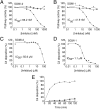Revised mechanism of complement lectin-pathway activation revealing the role of serine protease MASP-1 as the exclusive activator of MASP-2
- PMID: 22691502
- PMCID: PMC3387078
- DOI: 10.1073/pnas.1202588109
Revised mechanism of complement lectin-pathway activation revealing the role of serine protease MASP-1 as the exclusive activator of MASP-2
Abstract
The lectin pathway of complement activation is an important component of the innate immune defense. The initiation complexes of the lectin pathway consist of a recognition molecule and associated serine proteases. Until now the autoactivating mannose-binding lectin-associated serine protease (MASP)-2 has been considered the autonomous initiator of the proteolytic cascade. The role of the much more abundant MASP-1 protease was controversial. Using unique, monospecific inhibitors against MASP-1 and MASP-2, we corrected the mechanism of lectin-pathway activation. In normal human serum, MASP-2 activation strictly depends on MASP-1. MASP-1 activates MASP-2 and, moreover, inhibition of MASP-1 prevents autoactivation of MASP-2. Furthermore we demonstrated that MASP-1 produces 60% of C2a responsible for C3 convertase formation.
Conflict of interest statement
Conflict of interest statement: D.H., P.G., G.P., and P.Z. filed patent application for the SGMI inhibitors.
Figures






Similar articles
-
Cooperation between MASP-1 and MASP-2 in the generation of C3 convertase through the MBL pathway.Int Immunol. 2007 Feb;19(2):141-9. doi: 10.1093/intimm/dxl131. Epub 2006 Dec 20. Int Immunol. 2007. PMID: 17182967
-
Mannose-binding lectin (MBL)-associated serine protease (MASP)-1 contributes to activation of the lectin complement pathway.J Immunol. 2008 May 1;180(9):6132-8. doi: 10.4049/jimmunol.180.9.6132. J Immunol. 2008. PMID: 18424734
-
Molecular interactions between MASP-2, C4, and C2 and their activation fragments leading to complement activation via the lectin pathway.J Biol Chem. 2007 Mar 16;282(11):7844-51. doi: 10.1074/jbc.M606326200. Epub 2007 Jan 3. J Biol Chem. 2007. PMID: 17204478
-
MASP-2, the C3 convertase generating protease of the MBLectin complement activating pathway.Immunobiology. 1998 Aug;199(2):348-57. doi: 10.1016/S0171-2985(98)80039-9. Immunobiology. 1998. PMID: 9777418 Review.
-
Toward a structure-based comprehension of the lectin pathway of complement.Mol Immunol. 2013 Dec;56(4):413-22. doi: 10.1016/j.molimm.2013.05.007. Epub 2013 Aug 1. Mol Immunol. 2013. PMID: 23911397 Review.
Cited by
-
The Lectin Pathway of the Complement System-Activation, Regulation, Disease Connections and Interplay with Other (Proteolytic) Systems.Int J Mol Sci. 2024 Jan 26;25(3):1566. doi: 10.3390/ijms25031566. Int J Mol Sci. 2024. PMID: 38338844 Free PMC article. Review.
-
Mannose-Binding Lectin (MBL) and MBL-associated serine protease-2 (MASP-2) in women with malignant and benign ovarian tumours.Cancer Immunol Immunother. 2014 Nov;63(11):1129-40. doi: 10.1007/s00262-014-1579-y. Epub 2014 Jul 20. Cancer Immunol Immunother. 2014. PMID: 25038892 Free PMC article.
-
AmpliSeq Screening of Genes Encoding the C-Type Lectin Receptors and Their Signaling Components Reveals a Common Variant in MASP1 Associated with Pulmonary Tuberculosis in an Indian Population.Front Immunol. 2018 Feb 20;9:242. doi: 10.3389/fimmu.2018.00242. eCollection 2018. Front Immunol. 2018. PMID: 29515573 Free PMC article.
-
Recent advances into the role of pattern recognition receptors in transplantation.Cell Immunol. 2020 May;351:104088. doi: 10.1016/j.cellimm.2020.104088. Epub 2020 Mar 7. Cell Immunol. 2020. PMID: 32183988 Free PMC article. Review.
-
Key Components of the Complement Lectin Pathway Are Not Only Required for the Development of Inflammatory Arthritis but Also Regulate the Transcription of Factor D.Front Immunol. 2020 Feb 21;11:201. doi: 10.3389/fimmu.2020.00201. eCollection 2020. Front Immunol. 2020. PMID: 32153567 Free PMC article.
References
-
- Takeuchi O, Akira S. Pattern recognition receptors and inflammation. Cell. 2010;140:805–820. - PubMed
-
- Thiel S. Complement activating soluble pattern recognition molecules with collagen-like regions, mannan-binding lectin, ficolins and associated proteins. Mol Immunol. 2007;44:3875–3888. - PubMed
-
- Endo Y, Matsushita M, Fujita T. The role of ficolins in the lectin pathway of innate immunity. Int J Biochem Cell Biol. 2011;43:705–712. - PubMed
-
- Hansen S, et al. Collectin 11 (CL-11, CL-K1) is a MASP-1/3-associated plasma collectin with microbial-binding activity. J Immunol. 2010;185:6096–6104. - PubMed
Publication types
MeSH terms
Substances
LinkOut - more resources
Full Text Sources
Other Literature Sources
Molecular Biology Databases
Miscellaneous

